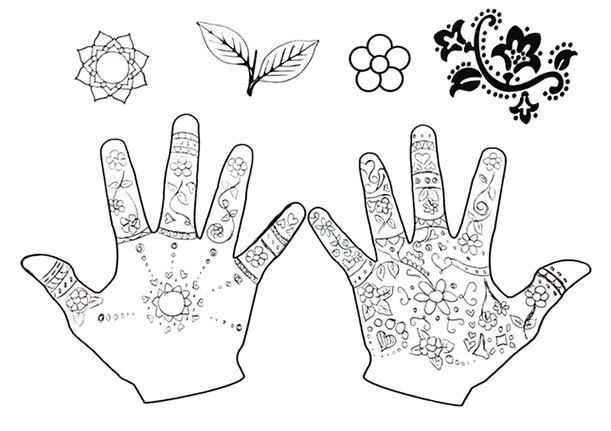BOOMbox: Makeup, Melanin, and More
February 16, 2021

Do you love to paint or decorate your hands? What about your face? Have you wondered about the ingredients of henna, makeup, and face paint? Read on for information and projects.
Henna Hands
Henna is a dye that originates in the plant Lawsonia inermis. Found in northern Africa, Australia, and Asia, this plant has medicinal value. The dye from its leaves is used to make henna paste, which can be applied on arms, hands, and feet. Learn more about henna and body painting from the Body Art collections at the Pitt Rivers Museum. Learn how to make henna with either powder or leaves.
Would you like to make your own henna design? Download a henna pattern template and watch a time-lapse video of making a henna design for inspiration.
Makeup and Face Paint Ingredients
Centuries ago, ash, beeswax, white lead, rice powder, and berry juice were some of the ingredients used in makeup. From the First Nations to China to Myanmar, people wear paint on their faces for various reasons. The reasons include self expression, fitting in with everyone else, as part of costumes, or for performances and ceremonies. The Pottawatomie and Ottawa nations used blue and red paint as protection for their warriors, and many other nations used face paint to show who belonged to the same family. The Chou Dynasty in ancient China used makeup to show who was rich and who was poor. People in Myanmar use thanaka, a cream made of bark, for decoration and sun protection.
At its core, all face paint is made of a pigment and things to help the pigment stick to your skin. The pigment makes the paint colorful and can include ingredients like ash for black, rice powder for white, berry juice or cochineal bugs for red, and mica, a type of mineral, for glitter. Other ingredients can include water, which helps dissolve the pigment, oil and wax to help the paint go on smoothly, and an emulsifier to help the oil and water mix together. Sometimes face paint includes other ingredients because they are useful, like sunscreen or medicine. All of these ingredients need to be nontoxic, which means that they won’t harm you. Make your own face paint by using food coloring, water, flour, cornstarch, and oil, as well as lotion to keep your skin soft.
Is it always appropriate to wear makeup or face paint that has cultural significance? Good question. An important first step is to consider context. Understanding why makeup or face paint is worn in a certain way is a great start. For example, you can learn the story behind the makeup worn by Disney’s Mulan. Or read about cultural appropriation in an article that is mostly about the cultural appropriation of costumes, but relevant to makeup and face paint as well.
Let’s not forget about another realm of makeup--special effects! Watch a rundown of special effects seen in Black Panther.
Melanin
Are you familiar with the word melanin? It’s a naturally occurring skin pigment present in humans and many other animals. Typically, this dark pigment is present in hair, skin, and the iris of the eye. The production of melanin is a biochemical process called melanogenesis (how to pronounce melanogenesis). The pigment is formed in organelles known as melanosomes, which are housed in hair follicles and skin cells.
What “tells” melanosomes to produce varying levels of melanin? And how does melanin richness play out in our communities? It turns out that our genes are responsible for determining skin color for the most part. Watch a TED-Ed talk about the science of skin color and the effects of sunlight on our skin, and the documentary 50 Faces of Melanin to hear how colorism (discrimination based on skin tone) affects the lives of British Black women.
The medical technology and makeup industries, along with the individuals who lead in these fields, carry biases that influence how products are designed. Consider the implications of medical devices designed for a certain skin tone. Read more about how a popular medical device encodes racial bias. Similarly, makeup has been manufactured to suit caucasian skin tones despite the fact that Black women spend about $465 million annually on skin-care products. This issue is even deeper than skin tone, since studies have shown that programs and students of dermatology do not adequately train for treating melanin-rich patients. For more on this, read an interview about the current state of the makeup industry.
To help early readers learn about melanin, read M is for Melanin: A Celebration of the Black Child, or watch a video of artist Kenturah Davis reading the book. Looking for more? Watch a TEDxYouth talk or read stories compiled by Project Colorism. Or how about we mix it up with some paints and try to match our skin tones? Watch a quick how-to video about color mixing for all skin tones, or watch a longer tutorial about using paint to make skin tones. Once you figure out your very own skin tone, consider drawing a self-portrait and put that paint blend to use.
Ingredient of the Week
Apple cider vinegar has been called a miracle cure for everything, including radiant skin. But is it? Learn about the myths and miracles of apple cider vinegar.
Person of the Week
Canadian-born Winnie Harlow rose to public prominence after appearing in America’s Next Top Model. Winnie is also known widely for speaking about vitiligo, a lifelong skin condition that began to affect her at age 4. Vitiligo occurs when the body’s immune system attacks melanocytes, which in turn causes them to stop creating enough melanin. This results in a patchy loss of skin color. Winnie recalls being bullied by others when she was a child in her TEDxTeen Talk. About 1% of people in the world, or 65 million people, have vitiligo. Read more about vitiligo.
Written by Veena, Eli, and Michelle.